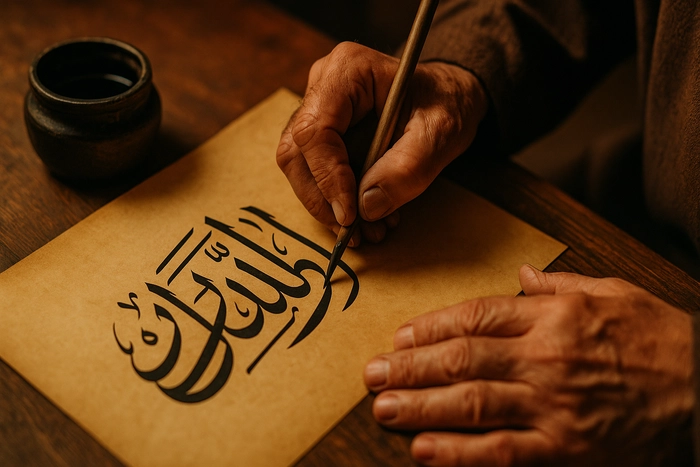The Significance of Islamic Calligraphy | History, Art & Spirituality
The old man's hands trembled slightly as he dipped his bamboo pen in ink. But the moment the nib touched paper, those same hands became steady as stone. I watched, mesmerized, as he transformed simple letters into living poetry through Islamic calligraphy.
He often muttered, “Every stroke of the brush is a prayer of art.” while working in his Damascus workshop. He made me realize that Arabic Calligraphy is more than just an artform, it's a divine calling to God himself.
Where It All Began
Back in the 7th century, when the first words of the Quran were being written down, nobody had Instagram filters or fancy fonts. What they did have was an unshakeable desire to make every word beautiful. These early masters of early islamic calligraphy weren't just writing – they were painting with words, turning each letter into a masterpiece. Imagine trying to write something so beautiful that it could capture the voice of God. That's what they were attempting, and that's how Islamic calligraphy art was born.
The First Letters
Strong as Stone
The first style they created was like the mountains themselves – strong, bold, and unmovable. They called it Kufic calligraphy, and if you've ever seen it, you know why it looks like it could stand for a thousand years. These weren't just letters; they were architecture in ink. The early Quranic texts written in this style weren't meant to be rushed through – they commanded you to stop, look, and really see each word.
Flowing Like Water
But as time passed, something interesting happened. Just as rivers smooth rough stones, the harsh angles of early scripts began to soften. New styles of Arabic calligraphy art emerged that flowed like honey, curving and swirling across the page. This wasn't just writing evolving – it was faith finding new ways to express itself.
A Golden Time
Picture yourself in Baghdad, about a thousand years ago. In every corner of the city, you'd find masters of Islamic calligraphy writing hunched over their work. Some were copying the Quran in the clear, readable Naskh script, making Quran calligraphy that even children could read. Others were creating massive Islamic calligraphy architecture for mosques, their letters climbing toward heaven like spiritual vines.
The Ottoman Touch
When the Ottomans came along, they looked at Arabic calligraphy writing and thought, "Let's make it dance." And dance it did. They created the Diwani script, full of curves that would make a ballet dancer jealous. Even their everyday writing style, Ruq'ah, had a bit of swagger to it. This wasn't your grandfather's modern islamic calligraphy – this was calligraphy with attitude.
More Than Just Pretty Writing
A Different Kind of Prayer
Here's something cool about Muslim calligraphy: many artists won't start writing without first performing ablutions, just like before prayer. They believe every stroke of Islamic calligraphy artwork is a form of worship. It's like meditation with ink – each curve of those Arabic calligraphy letters is a moment of connection with something bigger than ourselves.
Keeping History Alive
Think about it – through wars, disasters, and centuries of change, ancient Islamic calligraphy has survived. Each piece of Quran calligraphy art isn't just decoration; it's a time capsule, carrying messages from our ancestors to us, and hopefully to our grandchildren too.
Today's Take
Walk into any modern Muslim home, and you might see contemporary Islamic calligraphy that would make those ancient masters scratch their heads – in a good way. Today's artists are taking those traditional Islamic calligraphy designs and remixing them for our times. Some are using iPads instead of bamboo pens, creating Arabic calligraphy designs that bridge centuries.
Looking Forward, Looking Back
Islamic art and calligraphy communicates between the past and the present and connects faith and creativity. It's not an easy feat to be passed on for hundreds of years and still hold value and meaning in all the scriptures and artworks amongst the Muslim community. It embraces tradition, culture and faith.
You’ll find it in grand mosques, on delicate home decor, even on something as simple as a coffee mug. No matter where it appears, it carries a piece of something timeless. Islamic calligraphy is also seen in the holy book of Quran.
And maybe that’s why Islamic calligraphy writing feels so powerful. In a world that moves too fast, where we barely pause to take a breath, calligraphy reminds us to slow down. To notice the way a single stroke flows, to see the care and devotion in every curve and line. It’s not just about the words—it’s about the feeling they create.
Because isn’t that what art is really about? Not just making something beautiful, but making something that means something. Something that connects us—to our history, to each other, and maybe, in the quietest moments, to something far beyond ourselves.

